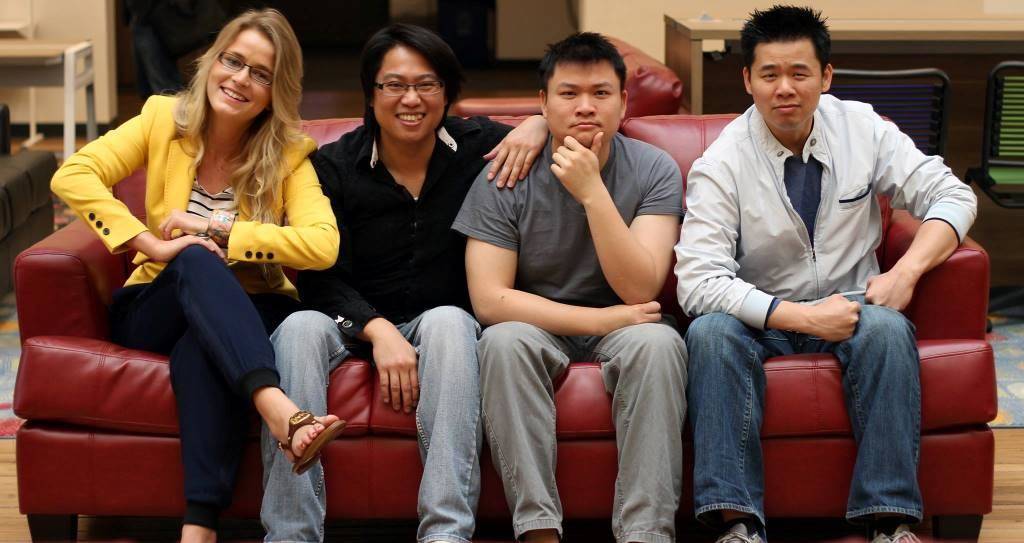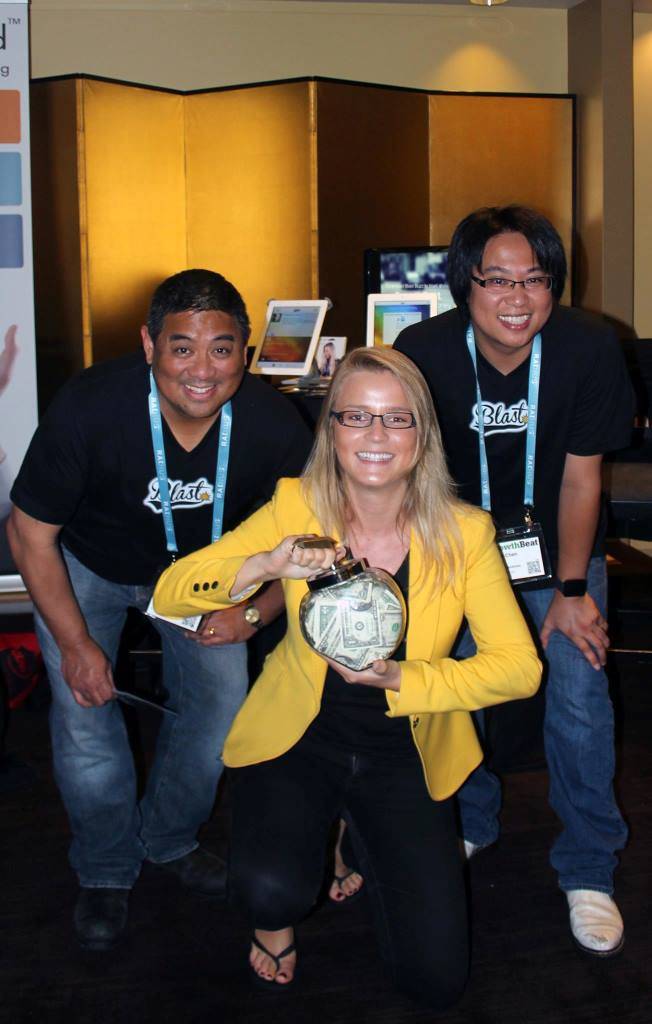Kerstin Karu is a typical Silicon Valley early-stage entrepreneur. Startuppers are a distinct kind of people that cannot be defined by their gender, age, nationality or education. Only one thing is certain: they are self-assured, optimistic and full of confidence. While talking to Kerstin these are the features you’ll notice above all.
Despite her young age – only 23 – she has travelled the world, studied hard and tried different occupations. For the past year, she’s been running her company Blast Buzz, a mobile and web application that provides customers with a possibility to virally advertise goods and services on social media networks in exchange for points or gifts.
Having completed an academic degree in marketing from the Lancaster University in 2013, Kerstin decided to get a more hands-on experience in business from the San Mateo-based Draper University of Heroes in the summer. She was accepted into the programme in the spring of 2013, which led her to spend the following summer in Silicon Valley. Little did she know that she was bound to stay.
As it tends to be the case for stories of this kind, Kerstin had heard about the school from a friend, while completing her final year in a university in the UK. Her friend from the university had been to Estonia, where he had heard about the Draper University, founded by Tim Draper, partner of the venture capitalist, Steve Jurvetson, who also happens to be a well-known Silicon Valley entrepreneur with Estonian roots (both Draper and Jurvetson recently became the first e-residents of Estonia). Both Kerstin and her friend applied to the programme and were accepted, while Kerstin also earned a scholarship that covered most of the USD9,500 worth of studies thanks to her rich set of experiences. Perhaps another contributing factor was the fact that there had been three Estonians in the previous class.
The ability to sell oneself successfully is definitely one of the key aspects in building a startup. One might have a great idea but if one does not know how to make it understandable to one’s potential investors or team, one can just as well forget about the big idea. The founder of one of the best known startup incubators in Silicon Valley, Y Combinator, Paul Graham coined the rules of successful startups already back in 2005: you need an idea, people, money and at least a vague understanding of what your customers want. If we add to the list the courage to stumble and fall, followed by standing up and trying again, we can recite Kerstin’s story based on the following points:
1. Be brave and experiment
While still studying at the Lancaster University near Manchester, UK, Kerstin was an active student running the university’s entrepreneurship and marketing societies and working as a regional manager for the National Association of College and University Entrepreneurs (NACUE).
One can easily say that Kerstin is not a typical Estonian, as she’s far too outspoken and lively. Perhaps it’s due to the fact that she was born in Canada, where her parents had migrated during the Soviet occupation of Estonia. They returned to Estonia after the country regained its independence in the beginning of the 1990s. As if one cultural shock was not enough, Kerstin and her mother also lived in Romania for a while in 1994, five years after the country had put an end to the cruel dictatorship of Nicola Ceausescu.
Back in Estonia, she graduated from one of the top schools in the country, the Tallinn French School, in 2010. She still has fond memories of her former high school that provided her with a strong basis in classical literature, foreign languages and arts, on top of a strong foundation in all other subjects core to the national curriculum. For a while she even dreamt of becoming an actress, but soon replaced this dream with a far more practical goal to study marketing instead. In order to reach her goal, she self taught herself graphic, video and web design when she was still in middle school.
Perhaps it was her interest in classical literature and arts that brought her to Greece a year before the end of high school. She did not go there as a tourist to admire old temples or pass along days by the seaside, but instead got a summer job selling tickets to concerts and parties on a beach promenade. She managed to sell enough tickets to quickly become one of the top sellers in the resort and was offered the position of an advertising manager, making her responsible for creating promotional videos for the resort. Kerstin was 18 at the time.
She also went back to Greece for the summer a year later; however, this time she wanted to try out a new job: “Although they offered me the same position as the year before, I wanted to try bartending before starting university in the autumn. I really enjoy entertaining people and felt that I could apply that to bartending.” She learned how to make cocktails and soon had her own counter to serve loyal customers who kept coming back.
By the time Kerstin went to the university, she became interested in search engine optimisation (SEO) and trying out different ways to boost websites on search engines. She created an online fashion retail site, which she ran from the UK, while targeting Estonian customers. To her great surprise, Estonian women were eager to buy clothes normally sold in typical high street stores in the UK, at much lower prices compared with Estonia. Although the sales took off well, she decided that this was not the business she wanted to pursue in the long term.
2. Find the right people
According to Graham, it is important to find an idea first and then find the right people to implement it with. Kerstin had it the other way round. The first “right person” on her path was probably Tim Draper, who became a role model for her, followed by her current co-founders.
“Draper makes you think big,” she praises her teacher a year after graduating Class 3. “He’s a very inspirational and optimistic person, there is no doubt in my mind that he’s very smart but at the same time kind of crazy in a good way. And all the people he invites to speak to the students are incredibly inspiring.” Among others, the past speakers at the Draper University have included well-known Silicon Valley titans, like Elon Musk, founder of SpaceX and Tesla; Tony Hsieh, founder of Zappos; Nolan Bushnell, founder of Atari and of course, Tim Draper’s own father Bill Draper, who is considered to be one of the founders of venture capitalism.
During the six week program, Kerstin came up with a business idea and decided not to immediately return to the UK after she had completed her studies. Instead, she stayed in San Mateo, helping run the new class and working on her initial business idea. The elaborate startup scene in Silicon Valley also played a big part, as it tends to offer a striving entrepreneur more experiences than any other place in the world. There are plenty of opportunities to network with like-minded people and reach out to those who have already achieved fame and fortune.
In one of those typical Valley networking events Kerstin started to talk to Mark Chen, a former software engineer at Cisco, who had recently left the corporate world to pursue entrepreneurship by starting a mobile app company. “We clicked instantly and realised we complemented each other’s skills,” Kerstin recalls. “I had a background in business and he knew software development like the back of his hand.” Mark also introduced her to his friends from Cisco and Adobe and the new team was born.
In addition to her team, it was yet again at a business networking event, where Kerstin met her mentor. Michelle Fisher is an angel investor who doesn’t mind allocating some of her time on advising striving young entrepreneurs about business development, as well as more complex issues crucial to succeeding in business. For instance, she has given Kerstin advice on how to succeed as a female entrepreneur in a male-dominated world of technology. It’s a well-known secret that some men tend to harass their female counterparts – consciously or unconsciously – in the hardcore blood-on-the-street entrepreneurial scene.
“If a man comes to you with an indecent proposal you simply have to play it down in style,” Kerstin knows from a first-hand experience. “Fortunately I have not had many unpleasant encounters of this kind, as I always try to stress with my appearance and attitude that I mean business. However, perhaps I would like to look more feminine from time to time, for example wear a dress and lipstick, but then I’d have to face the dominating prejudices: what does this 23-year-old woman know about entrepreneurship!?”
3. Find the right idea
All in all, Kerstin seems to have been rather successful in establishing herself as someone to be taken seriously. Being the only woman in a team of men she started to work on the idea how to create a unified identity code system to replace all common items in a wallet, as well as keys. The name of the working version was “Karu” (Kerstin’s last name means “bear” in Estonian, which her cofounders thought would be an extraordinarily cool and strong name).
Just over a year ago Kerstin and her team decided to test their team working abilities and resistance to pressure at the Dreamforce hackathon in San Francisco. The idea they came up with, Blast Buzz, grew on the team so much that they decided to put Karu on hold and pursue the new venture.
In November 2014 Blast Buzz celebrated a year from the birth of the idea – they incorporated in January. But what is it that they do exactly?
In essence it’s peer-to-peer marketing. By using the app a person can create mouth-to-mouth buzz in social networks among his/her friends, thereby earning premium points that will be converted into money, vouchers or products. “92% of people do not care about (public) advertising but only their friends recommendations,” Kerstin knows from her marketing books. “Let’s say I drink a bottle of Coca-Cola and share a picture of it on Instagram and if ten of my friends like it, Coca-Cola will award me as a loyal customer by giving me the next bottle for free or some company products with their logo on it.”
After launching the first version of Blast Buzz and testing it with the initial user base, the team is now working on implementing their vision of brand growth through the influence of fans on a brand new platform. By partnering with selected brands, they aim to introduce a one-of-a-kind fan relationship management and influencer marketing platform in 2015.
4. Find money
There is only so much you can do with pure enthusiasm alone, even if you have the best team in the world. Great ideas need a certain amount of starting capital to get executed. Kerstin managed to impress Tim Draper enough to get him to invest in her idea, but she emphasises that graduating from the Draper University doesn’t guarantee an investment from him.
Instead, as is the case with any investor, you need to have a business idea with great potential and an incredible team behind it. “If he happens to invest in some of his students’ startups, there is no typical way how he does that. It could be in the form of money, providing free housing or a co-working space (at the Draper University),” Kerstin explains. Therefore it makes more sense to look at the most common model used by investors when funding early stage startups, which is issuing a convertible note, ie a short-term debt that converts into equity. To put it more simply: investors loan money to a startup as its first round of funding; and instead of requesting for their money back with interest added, they receive shares of preferred stock (usually ranging between 5-20% of the company), as part of the startup’s initial preferred stock financing, based on the terms of the note. The most common deadline is 12 months.
“If you expand the horizons of young people they’ll go out there and do great things,” Kerstin muses. “If Tim Draper is willing to invest in your startup, he’ll also make it worthwhile.”
5. Be ready to fail
After listening to Kerstin’s stories, one cannot but wonder if the road to success is not supposed to be paved with failure? It seems she has only encountered good luck and praise for her great achievements. Actually it’s not all that easy and she does not shy away from confessing she’s not always successful. “It takes failing and failing again to succeed,” she adds.
As part of her “finals” at the Draper University she had to pitch her business idea in front of a panel of investors and a large audience. “Oh, that pitch day was just awful!” she shrugs in horror. “You only have two minutes to talk about something that you feel so passionate about. I was overly confident in myself prior to the pitch day, as I had done a lot of public speaking at my university in the UK, and I had also given a TEDx talk shortly before coming to the Draper University, but this was completely different. These two minutes went by in a flash and then the clicker jammed, so I only got through half of my slides…”
But life does not stop because of one unsuccessful presentation and keeps going regardless of the obstacles thrown on one’s way. “I failed giving this pitch, but as a result I learned that you can never practise too much. Play your slides through in front of a friend or practise talking to a mirror – do either or both more than once before you go in front of investors. You’ll always have those butterflies in your stomach before you need to perform in front of an audience, so the more you practise, the less those butterflies will kick in.
Kerstin adds that one of her favourite sides, what comes to Silicon Valley and the US business culture overall, is the fact that (unlike anywhere in Europe) failing is considered to be a healthy learning experience. It’s okay to fail, as this will help you analyse your actions and avoid making the same mistakes in the future, without bearing the sign of a “loser” for the rest of your life. “If it happens so that we need to pursue plan B, we’ll try a new business model and a different platform. And if we fail again, we’ll stick to developing software but perhaps in a different field.”
I
The article was published in Estonian on California-based Eesti by the Bay website. Cover photo by Kätlin Rebane.





Great story of a young entrepreneur…….Thanks, Ms Ede…